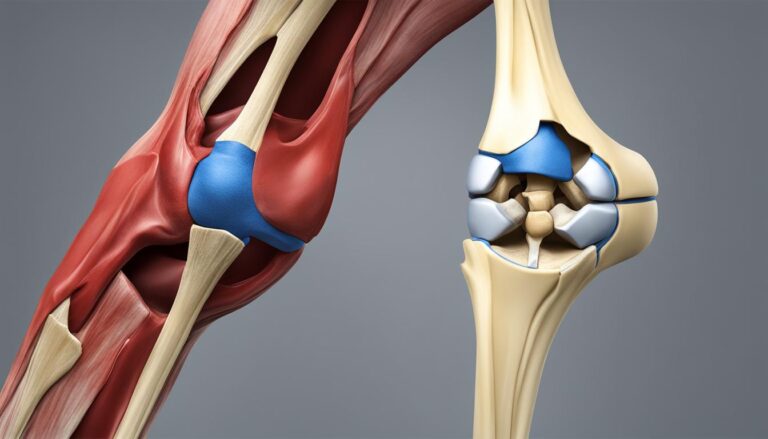Remote Work and Digital Nomadism for Knee Pain Sufferers
As remote work and digital nomadism continue to gain popularity, individuals with knee pain are finding opportunities to work from anywhere and embrace the digital nomad lifestyle. This article aims to provide tips and strategies for individuals with knee pain who are interested in pursuing remote work or living as digital nomads. We will explore knee pain relief techniques, remote work accommodations, exercises for knee pain relief, and remote work ergonomics, all aimed at ensuring a comfortable and productive work environment for individuals with knee pain.
Key Takeaways:
- Remote work and digital nomadism offer flexibility and accommodation for individuals with knee pain.
- Managing knee pain while working remotely requires addressing unique challenges like prolonged sitting and lack of a stable office setup.
- Incorporating regular movement breaks, practicing proper ergonomics, and using knee-friendly workstations can help manage knee pain while working remotely.
- There are knee-friendly remote job options available, such as virtual customer service, online tutoring, content writing, graphic design, and virtual assisting.
- Exercising regularly and focusing on knee-strengthening exercises can provide relief and prevent further knee pain.
With the right strategies and a focus on self-care, individuals with knee pain can successfully navigate the world of remote work and embrace the digital nomad lifestyle while prioritizing their health and well-being.
The Challenges of Working Remotely with Knee Pain
Working remotely with knee pain can present unique challenges for individuals. Prolonged sitting, lack of a stable office setup, and cramped seating spaces during travel can contribute to knee pain and discomfort. It is important to understand and address these challenges in order to prevent and manage knee pain while working remotely.
One of the main challenges faced by remote workers with knee pain is the prolonged sitting that often comes with remote work. Sitting for extended periods can put additional strain on the knees, leading to increased pain and discomfort. Finding ways to incorporate regular movement breaks throughout the workday can help relieve this strain and prevent further discomfort. Simple stretching exercises or short walks can provide much-needed relief and improve blood circulation in the knees.
Another challenge is the lack of a stable office setup when working remotely. Remote workers may find themselves working from various locations such as coffee shops, libraries, or even their own homes. These environments may not always provide the ergonomic support needed to alleviate knee pain. It is important for remote workers to invest in portable ergonomic equipment such as adjustable laptop stands or ergonomic cushions to create a more comfortable and supportive work environment.
“Working remotely with knee pain can be challenging, but with the right accommodations and strategies in place, it is possible to manage the pain effectively.”
Traveling while working remotely can also pose challenges for individuals with knee pain. Whether it’s long flights or cramped seating on trains or buses, prolonged sitting in these confined spaces can exacerbate knee pain. Remote workers should prioritize selecting travel options that offer more legroom or consider taking breaks during long journeys to stretch and relieve knee pressure.
By addressing these challenges, remote workers with knee pain can effectively manage their symptoms and create a more comfortable and productive work environment. With proper ergonomic support, regular movement breaks, and mindful travel choices, individuals can minimize knee pain and continue to excel in their remote work endeavors.
| Challenges of Working Remotely with Knee Pain | Solutions |
|---|---|
| Prolonged sitting | Incorporate regular movement breaks and stretching exercises throughout the workday |
| Lack of a stable office setup | Invest in portable ergonomic equipment such as adjustable laptop stands or ergonomic cushions |
| Cramped seating spaces during travel | Prioritize travel options that offer more legroom and take breaks to stretch during long journeys |
Tips for Managing Knee Pain while Working Remotely
Managing knee pain while working remotely is essential to ensure comfort and productivity. To help remote workers with knee pain, here are some strategies and tips:
- Incorporate regular movement breaks: Take short breaks every hour to stretch and move around. This will help alleviate knee stiffness and improve circulation.
- Practice proper ergonomics: Set up a knee-friendly workstation by using an ergonomic chair and desk. Make sure your knees are at a 90-degree angle and supported by a footrest or cushion.
- Use knee-friendly workstations and equipment: Invest in an ergonomic keyboard, mouse, and other tools that reduce strain on the knees. This will minimize discomfort and prevent long-term damage.
- Implement exercises for knee pain relief: Incorporate exercises specifically targeted at strengthening the muscles around the knee joint, such as stretching, leg lifts, squats, and lunges. These exercises can be done during breaks or before and after work.
- Seek professional help or physical therapy: If the knee pain persists or worsens, consult a healthcare professional or physical therapist. They can provide personalized guidance and treatment options to manage and alleviate the pain.
By following these tips, remote workers with knee pain can effectively manage their symptoms and ensure a comfortable and pain-free work experience. Remember to prioritize self-care and listen to your body’s needs.
Knee-Friendly Remote Jobs for Individuals with Knee Pain
For individuals with knee pain, finding remote job options that prioritize their comfort and well-being is crucial. Fortunately, there are many knee-friendly remote jobs available that allow individuals to work from the comfort of their own homes while minimizing physical strain on their knees.
Here are some examples of knee-friendly remote jobs:
| Job Title | Description |
|---|---|
| Virtual Customer Service Representative | Providing customer support and assistance over the phone or through online chat platforms. |
| Online Tutor | Teaching and helping students with various subjects through virtual platforms. |
| Content Writer | Creating written content for websites, blogs, and online publications. |
| Graphic Designer | Designing visual materials, such as logos, illustrations, and marketing materials. |
| Virtual Assistant | Providing administrative, organizational, and personal support to clients remotely. |
These knee-friendly remote jobs allow individuals with knee pain to work in a supportive environment that minimizes physical strain on their knees. By exploring these job opportunities, individuals can find work-from-home options that accommodate their needs and provide the flexibility they require to manage their knee pain effectively.

Remote Work Exercises for Knee Pain Relief
Incorporating exercises into your remote work routine can help alleviate knee pain and strengthen the muscles around the knee joint. By engaging in regular physical activity, you can improve flexibility, reduce discomfort, and enhance overall knee health. Here are some effective exercises for knee pain relief that you can easily integrate into your remote work lifestyle:
- Stretching exercises: Start your day with gentle stretches to warm up your muscles and increase flexibility. Focus on stretching the muscles around your knees, such as your quadriceps and hamstrings. Hold each stretch for 15-30 seconds and remember to breathe deeply.
- Leg lifts: Sit in a chair and straighten one leg in front of you. Lift your leg as high as you comfortably can, hold for a few seconds, and then slowly lower it back down. Repeat this exercise 10-15 times on each leg to strengthen your quadriceps.
- Squats: Stand with your feet shoulder-width apart and lower yourself into a squatting position. Aim to keep your knees aligned with your toes and your back straight. Slowly rise back up, engaging your leg muscles. Start with 10 squats and gradually increase the number as your strength improves.
- Lunges: Take a step forward with one leg and lower your body until both knees are at a 90-degree angle. Keep your front knee directly above your ankle and your back knee slightly above the floor. Push through your front heel to return to the starting position. Repeat this exercise 10-15 times on each leg.
- Low-impact cardio exercises: Engage in activities like walking, swimming, or cycling to improve cardiovascular health and maintain a healthy weight. These low-impact exercises help reduce stress on the knees while providing overall health benefits.
Remember to start slowly and gradually increase the intensity of your exercises over time. Listen to your body and stop any exercise that causes pain or discomfort. If you have any concerns or specific needs, consult with a healthcare professional or physical therapist for personalized guidance.

Regular exercise can greatly contribute to knee pain relief and help you maintain a healthy and active lifestyle. Incorporating these exercises into your remote work routine will not only benefit your knee health but also enhance your overall well-being.
Remote Work Ergonomics for Knee Pain Prevention
When working remotely, it is crucial to prioritize ergonomics to prevent knee pain and discomfort. By creating a knee-friendly workstation, you can ensure a comfortable and productive work environment. Here are some ergonomic tips for remote workers with knee pain:
Choose an ergonomic chair: Select a chair that provides proper support and promotes good posture. Look for adjustable features such as height, lumbar support, and armrests.
Set up an ergonomic desk: Ensure that your desk is at the appropriate height to maintain good knee alignment. Use a keyboard tray or adjustable desk to achieve the correct positioning.
Maintain proper posture: Sit up straight, with your feet flat on the floor. Avoid crossing your legs or sitting for extended periods without breaks.
Use a footrest or cushion: If your feet do not reach the floor comfortably, use a footrest or cushion to provide support and reduce pressure on your knees.
Remember that taking regular breaks to stretch and move throughout the workday is essential for preventing knee pain and stiffness. Stand up, walk around, and perform simple stretches to keep your joints flexible and relieve any tension. Now, let’s take a look at a knee-friendly workstation setup:
| Workspace Component | Recommended Features |
|---|---|
| Ergonomic Chair | Adjustable height, lumbar support, armrests |
| Ergonomic Desk | Height-adjustable, keyboard tray |
| Footrest or Cushion | Supports feet and promotes good knee alignment |
Having a knee-friendly workstation that prioritizes ergonomics is vital for preventing knee pain and maintaining your overall well-being. By following these tips, you can create a comfortable and efficient work environment that minimizes strain on your knees.
Conclusion
Remote work and digital nomadism offer viable solutions for individuals with knee pain. By implementing the tips and strategies discussed in this article, you can effectively manage knee pain, prevent further discomfort, and find knee-friendly remote job opportunities. Making use of exercises for knee pain relief and practicing proper remote work ergonomics will ensure a comfortable and productive work environment. With these strategies in place, you can successfully navigate remote work and embrace the digital nomad lifestyle while prioritizing your health and well-being.
Managing knee pain while working remotely requires a proactive approach. Incorporating regular movement breaks, practicing good ergonomics, and utilizing knee-friendly workstations and equipment are crucial strategies. Additionally, engaging in exercises specifically designed for knee pain relief can strengthen the muscles around the knee joint and enhance pain management.
By opting for knee-friendly remote job options such as virtual customer service representatives, online tutors, content writers, graphic designers, and virtual assistants, you can work from a supportive environment that minimizes physical strain on your knees. Prioritizing knee pain management and prevention while working remotely will allow you to maintain a healthy work-life balance and enjoy the flexibility and comfort that remote work offers.
FAQ
What are some tips for managing knee pain while working remotely?
Some tips for managing knee pain while working remotely include incorporating regular movement breaks, practicing proper ergonomics, using knee-friendly workstations and equipment, implementing exercises for knee pain relief, and seeking professional help or physical therapy when needed.
What are some knee-friendly remote job options?
Some knee-friendly remote job options include virtual customer service representatives, online tutors, content writers, graphic designers, and virtual assistants.
What are some exercises that can help relieve knee pain while working remotely?
Some exercises that can help relieve knee pain while working remotely include stretching exercises, leg lifts, squats, lunges, and low-impact cardio exercises.
How can I create a knee-friendly workstation while working remotely?
You can create a knee-friendly workstation while working remotely by using an ergonomic chair and desk setup, maintaining proper posture, using a footrest or cushion, and adjusting the height of your workstation to promote good knee alignment.
Is remote work a viable option for individuals with knee pain?
Yes, remote work can be a viable option for individuals with knee pain. By implementing the tips and strategies mentioned above, individuals can effectively manage their knee pain, prevent further discomfort, and find knee-friendly remote job opportunities.







